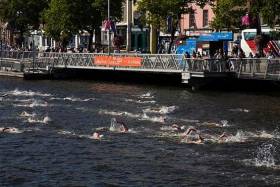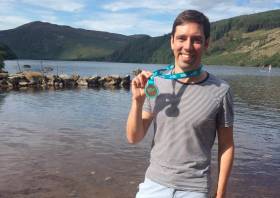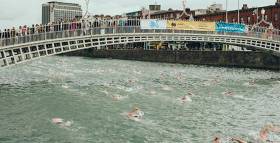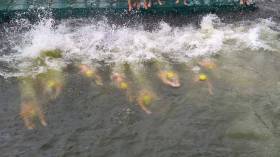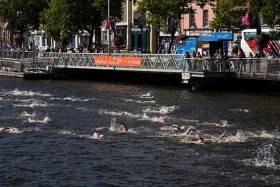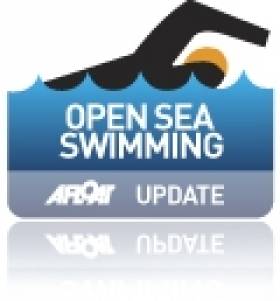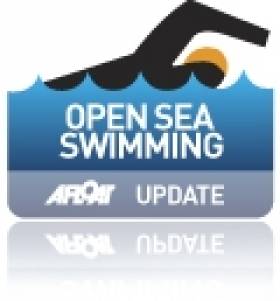Displaying items by tag: Liffey Swim
102nd Liffey Swim Attracts Nearly 500 Competitors
The annual Liffey Swim was held in Dublin city centre on Saturday (24 September) with nearly 500 people taking part, as RTÉ News reports.
Dublin Swimming Club’s Ken Dent took the men’s honours, leading from the outset and setting a time of 38 minutes from the Guinness Brewery to Custom House Quay — the swim’s traditional route.
Meanwhile, Melissa Corbally from Dublin’s NAC Masters Swimming Club was first among the women with a time of 47 min 51 sec, and described her win as “a very big surprise”. RTÉ News has more HERE.
This was the 102nd edition of the Liffey Swim, an annual event since 1920 save for a break in 2020 in the first months of the COVID pandemic.
100th Liffey Swim Sees One Of Its Youngest Ever Winners
The 100th edition of the Liffey Swim saw one of its youngest ever winners, as 15-year-old Mark Hanley from Meath clinched the men’s title yesterday afternoon (Saturday 3 August).
“Never in a million years did we think he’d win it,” his father Barry told Independent.ie of the schoolboy who has to juggle training with studies for his recently completed Junior Cert.
Fellow Meath swimmer Sinead Delaney was victorious in the women’s division of the race from St James’ Gate to Custom House Quay.
This year’s centenary event went ahead amid concerns over the river’s water quality following heavy rains earlier in the week that once again overwhelmed the city’s wastewater treatment infrastructure.
Dublin City Council warned that the most recent test results were “exceptionally poor”.
But race winner Mark commented: “It was grand, I actually think it was cleaner this year than last year. Less gunk on the top.”
Independent.ie has more on the story HERE.
RTÉ Journalist Wins Men’s Race In 99th Liffey Swim
#LiffeySwim - RTÉ journalist Paul O’Flynn fulfilled his “lifelong dream” of winning the Liffey Swim men’s race in the event’s 99th running yesterday afternoon (Saturday 1 September).
The Half Moon Swimming Club member finished with a time of around 43 minutes with an eight-minute handicap, as RTÉ News reports.
Trina Muldoon of Clontarf Swimming Club won the women’s race on the course that ran from St James’ Gate to the Custom House.
99th Liffey Swim Will Make Waves This Afternoon
#LiffeySwim - Some 500 swimmers are expected to take a dip in Dublin city centre this afternoon (Saturday 1 September) in the 99th running of the Liffey Swim.
Now sponsored by Jones Engineering and organised by Leinster Open Sea, the Liffey Swim was first run in 1920 and was soon after immortalised by Jack B Yeats’ Olympic medal-winning painting.
However, the tradition is very much alive and well, and the Liffey Swim today is the oldest continually run annual swimming race in Europe.
Spectators for this year’s event should plan to take their spots before the men’s race from 3pm and the women’s race from 4pm, both from the Rory O’Moore Bridge at St James’ Gate to the Custom House.
Dublin Swimmers Do Double In 98th Liffey Swim
#LiffeySwim - The 98th Liffey Swim on Saturday (9 September) was a double for Dublin Swimming Club, according to BreakingNews.ie.
Colin Monaghan and Anne Marie Bourke won the men’s and women’s races respectively over the 2.2km course from the Rory O’Moore Bridge at Croppies Acre to the Loop Line Bridge.
Nearly 500 swimmers took part in the near-century-old institution, now run annually by Leinster Open Sea Swimming and the only swimming race through a European capital, says TheJournal.ie.
Hundreds Make A Splash In 97th Liffey Swim
#LiffeySwim - "Perfect" conditions greeted the 430 swimmers who took a dip in the capital's river for the 97th Liffey Swim last weekend, as TheJournal.ie reports.
Brian Murray and Jennifer Gilbert were the respective men's and women's winners in the 2.2km race from the Rory O'Moore Bridge near Croppies Acre to the Loop Line Bridge at the Custom House on Saturday 6 August.
As previously reported on Afloat.ie, the annual Liffey Swim run by Leinster Open Sea Swimming is one of the most renowned and unique races of its kind in the world.
And photographer Donal Moloney was on hand to capture some stunning images of the day, which he's made available as a Facebook gallery HERE.
Liffey Swim Set For First Saturday In August
#LiffeySwim - The 97th Dublin City Liffey Swim will take place on Saturday 6 August.
The men's race will kick off from 1.30pm at Croppies Acre heading downstream beneath 12 of the city's bridges as far as the Loop Line Bridge, with the women's race from 2.30pm.
Run annually by Leinster Open Sea Swimming, the 2.2km Liffey Swim is one of the most renowned open sea races throughout the world – its excitement captured in Jack B Yeats' famed painting from 1923.
It is also unique in that Dublin is the only capital in Europe to have a swimming race through the middle of the city.
Hundreds Brave Dublin City's Waters In 95th Liffey Swim
#LiffeySwim - Dublin celebrated its 95th Liffey Swim yesterday as more than 360 people took to the river's waters yesterday (13 September) for the annual race through the heart of the capital.
As The Irish Times reports, 257 men and 111 women set off from the quays at the Guinness brewery on the more than 2km downstream course towards the Loopline Bridge, swimming beneath the majority of the city's landmark spans.
And almost all of the swimmers completed the race, with Ger Wilkes of the North Dublin Winter Swimming Club coming first among the men, while paramedic Rachel Lee was the first woman to reach the Custom House
The Irish Times has more on the story HERE.
Liffey Swim to Attract Hundreds of Swimmers for Dublin City Festival
#liffeyswim – The Lord Mayor Oisín Quinn will officially start the 94th Liffey Swim, supported by Dublin City Council, this Saturday 24th August as hundreds of brave swimmers take the plunge. This year's race will start at the Loop Line Bridge beside Butt Bridge and finish at the pontoon on the North side of the river beside the East Link Toll Bridge in front of the O2.
The 94th Dublin City Liffey Swim, supported by Dublin City Councilwill start at the Loop Line Bridge beside Butt Bridge and finish at the pontoon on the North side of the river beside the East Link Toll Bridge in front of the O2.
The 1,600-metre race, organised by Leinster Open Sea Swimming Club and supported by Dublin City Council will commence at 12.30pm with over 300 entrants taking to the water for the historic swim.
The inaugural Liffey LivingFestival will take the infectious atmosphere of the swim on in to the Grand Canal Dock post race for free, family friendly activities such as giant sized street games, a live band, ambient DJ and a specially erected floating open-air cinema, showing water themed movies! Dublin City Council's Liffey Living Festival will run from 3pm -10.00pm
WHEN:
SATURDAY 24th AUGUST 2013
MENS LIFFEY SWIM COMMENCES AT 12.30PM
WOMENS LIFFEY SWIM COMMENCES AT 1.30PM
Lord Mayor to Fire Starting Gun at Dublin's Liffey Swim
This Saturday, 11th September, the Dublin City Council sponsored Liffey Swim celebrates its 90th anniversary as 237 men and 114 women take the plunge, having completed 4 qualifying races on the 2010 Leinster Open Sea Swim Calendar. Dublin's Lord Mayor, Gerry Breen will fire the starting gun for the men's race at 13.30hrs and the women's race at 14.15hrs. The 2.2 kilometre swim begins at Rory O'More Bridge, Watling Street and finishes at the Custom House.
The Swim is open to competitors of all ages, abilities and nationalities, with teenagers pitting their strengths against 70 year olds and club swimmers from all over the country competing against their international counterparts. Don Barry is the oldest competitor at age 70 while Charlie McCarthy is the youngest at age 12.
According to the Lord Mayor, "the City Council is proud to sponsor the Liffey Swim which is a one of our landmark events in Dublin this year, to mark our designation as European Capital of Sport. I applaud the efforts of Swim Ireland, Leinster Region Open Sea Committee, who do an excellent job working closely with the City Council in successfully delivering this uniquely Dublin event, year after year. Attracting as it does a growing number of competitors from home and abroad, the Swim is highly regarded. I would also like to like to wish my colleague on the Joint Policing Commission, Assistant Gárda Commissioner, Mick Feehan the very best of luck in the race – I think he'll need all the luck he can get up against such stiff competition".
"There is something for people of all ages to enjoy at the event, with face-painters, performing clowns and live music from the Artane Boys Band on offer at Custom House Quay during the race. I encourage everybody in Dublin on Saturday afternoon to follow the race along the quays and cheer on the swimmers, from the many great vantage points along the Liffey walls, bridges and boardwalks", said the Lord Mayor. "It's a physically demanding race but a great day out for both competitors and spectators".
The race will feature 3 generations of 1 family swimming: John, Sharon and Hayley Pickering. The winner of last year's men's race, Pat O'Driscoll, will be again joined in the race by his son Daire who recorded the fastest time in last year's men's race. John McCarthy will be battling it out with his 12 year old son Charlie, who will be the youngest competitor in the race.
This year's race also includes a number of Irish swimmers who have completed the gruelling English Channel swim: Julie-Ann Galloway, Lisa Howley, Ann McAdam and Eoin Gaffney.



























